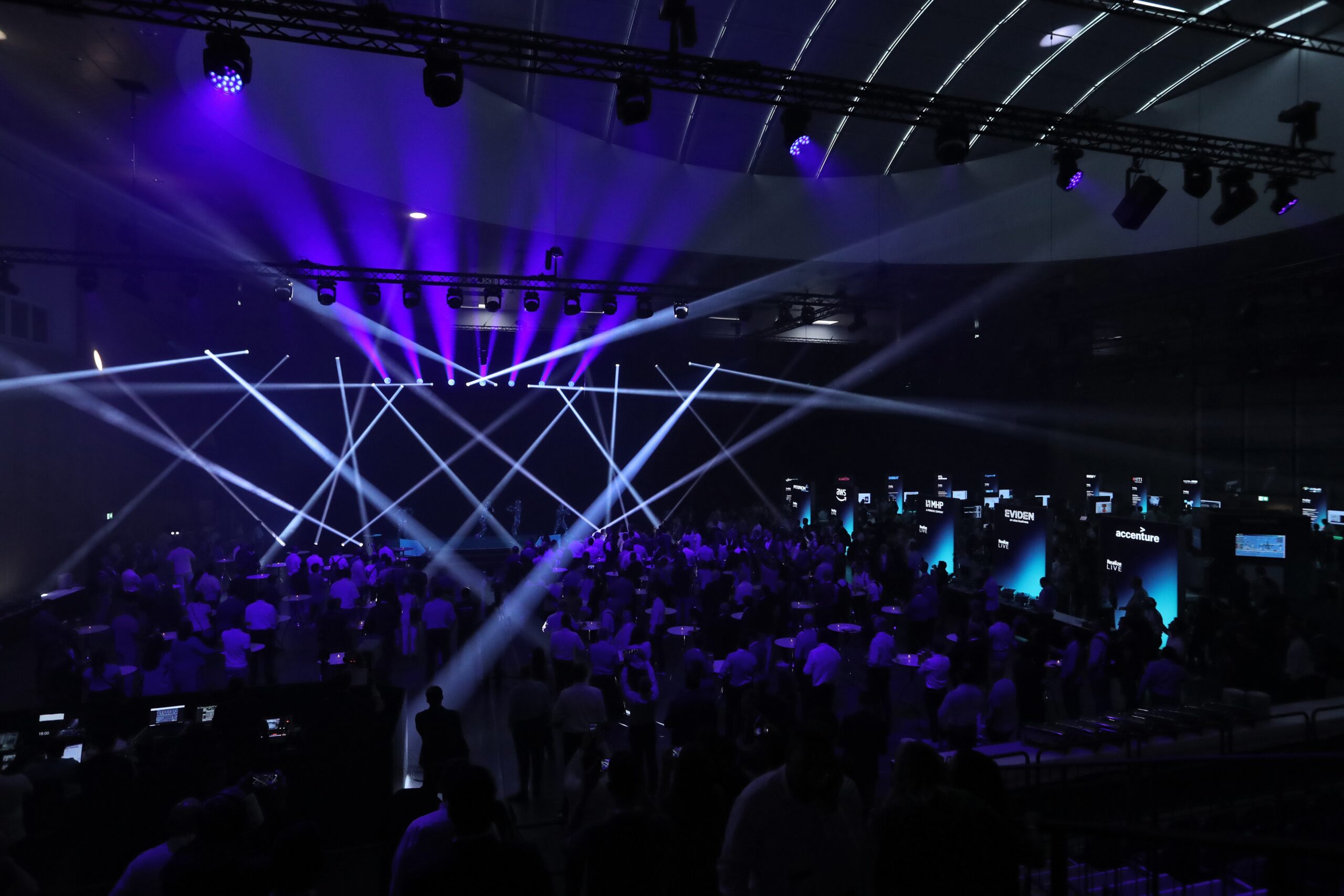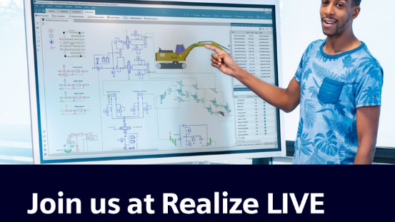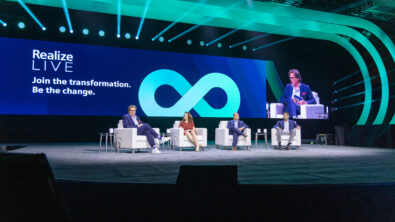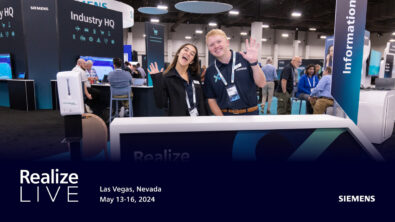Realize Live Europe Day 2 Wrap-Up Podcast

My colleague Stephen and I have reflected on Realize Live Europe after day two. We gained valuable insights from our different perspectives – Stephen conducted one-on-one interviews with customers, while I attended numerous presentations.
We also discovered a new term: VUCA. Listen to our wrap-up discussion to learn more about this term and our other intriguing insights.
Transcript
Stephen Ferguson:
Hello and welcome to the day two wrap up podcast from Realize live in Munich, where I am joined by roving reporter Chad Ghalamzan, who has been in the sessions today experiencing what engineers have to say about the future of engineering. What have you learned today, Chad?
Chad Ghalamzan:
Hi Stephen it’s well it’s been a very interesting day. First of all, I’m a little less jet lagged. I
Stephen Ferguson:
Was gonna say, you seem less grumpy than did yesterday cuz you were kind of a bit, you know, it was late yesterday. It’s late today, but you’ve had more sleep,
Chad Ghalamzan:
I guess, you know, I’m getting more used to local time here in in Munich than, than I was yesterday, but,
Stephen Ferguson:
And you’ve been inspired by all the great presentations
Chad Ghalamzan:
I have been. Yeah. The, the knowledge and and inspiration that has come by attending all these great sessions today has revitalized me for sure. But all, all kidding aside no, it’s been a, a very interesting day, the sessions I attended. You know, the one thing that comes to mind first of all is, is just how diverse the people here are in terms of what, what they do with, with SImcenter and actually the entire Siemens Xcelerator portfolio. I mean, when
Stephen Ferguson:
You look at them and where they come from
Chad Ghalamzan:
As well, where they come from their backgrounds, but, but, but what the, the software is used for or how they apply it, it’s, it’s yeah, it’s quite fascinating to see the wide range of applications that are being presented here.
Stephen Ferguson:
Have any main themes emerged from the talks today? Or has it been, has it been so diverse that you haven’t been able to pick any out?
Chad Ghalamzan:
There’s definitely been main themes, not the ones we talked about yesterday but we’ll get to that I think a little bit later in the conversation. I think one thing you, when you listen to people and, and see what they’re presenting, innovation comes up all the time that the need to be more innovative. So it’s a driving force in a lot of their activities. They, they see it as a key factor in establishing an advantage, you know, regardless of, of what industry they’re in. But the problem with innovation is that it comes with the risk. And the risk is the trade off that they have to leverage between the two. How innovative do they want to be? How much of a risk do they want to take? And when you’re using physical prototypes where you’re not doing everything digitally, that risk is much higher, both in terms of cost and the cost of if it fails. Whereas when you do everything digitally, obviously, that that risk is diminished significantly. So the way to mitigate that risk is to go through the digital transformation and, and digitize every aspect of their business. And you’re seeing that in, in quite a bit in all the presentations.
Stephen Ferguson:
So I didn’t get into many presentations again today, but I did see the keynote this morning from Ducati. And, and the point that he was basically making is, I think they’re talking for position of ring winning the, the triple crown of motorbike racing last year, having won all the trophies possible. And so they know about taking risks and they know about being innovative and, and, and the payoff from being innovative as well. So,
Chad Ghalamzan:
And they, and they were able to do that through their digital transformation. They, they actually mentioned that in their presentation that if they hadn’t done a digital transformation, they would not have been able to explore the innovations they did because in their case, I believe they were mentioning how they only get the race bike weeks before the race. And if, if it fails at that point, they’re in trouble. So their failures have to come digitally and that’s the only way that they can mitigate that risk.
Stephen Ferguson:
And they’re also showing how there’s the, they, they managed to demonstrate it was long thought not to be possible to generate downforce on a sports bike as well. And so, you know, their, their title one in bike used Little Air Force built into the design, which generated downforce, which is the same way that Formula One cars get to go around corners faster as well. So another direct payoff from, from that appetite for risk and a payoff in terms of innovation.
Chad Ghalamzan:
Absolutely. Both presenters this morning in the first session, were talking about how they have one clear goal and they have one shot to make it right. The other presenter forLuna Rossais competing in America’s Cup said the same thing. They all have a very short time with the boat before the race. And if it isn’t properly tested beforehand, if they don’t leverage simulation and digital twins beforehand, it would be impossible for them to, to approach the race with any kind of confidence that their boat will succeed.
Stephen Ferguson:
So, but I think, I guess one of the differences between those guys, both of whom are competing to win a trophy, yes. So the, their aim is really what they have to do in the future is really clear. They have to be faster than anybody else across a certain course. Lots of the companies I’ve talked to today have been, especially in the automotive space, but across the whole, I think of industry are at this point where they have to chase several technologies in the future, especially to, with kind of decarbonization, because we don’t know if the future’s gonna be all electric, if it’s gonna be using hydrogen, if it’s gonna be using biofuels, it’s gonna be used in a mixture of all of those above. And so lots of those companies at the moment, not just chasing one thing but having to chase all these things in parallel, which is kind of a unique time I think as well. So yeah, it doesn’t only happen in sports, it happens everywhere, but sometimes the objectives aren’t quite as clear.
Chad Ghalamzan:
Absolutely. And in fact, the pressure to be nimble with such an inflexible and unforgiving goal is a pressure that’s pretty much on all entities at this point. Everyone is being driven to do things faster and cheaper. That’s the only way to secure an advantage that, that exploring these innovative solutions. But bringing those solutions to market as soon as possible. But again, with all that uncertainty makes that job twice as difficult. And actually, there was a term, one of the presenters used this morning that I thought was very interesting. He said, we live in a VUCA world. And he said, it’s VUCA because we live in a volatile, uncertain complex and ambiguous world. And I thought that captured quite a bit of what engineering is right now, because there is a lot of emerging technologies and it’s difficult to know which one is going to necessarily come out as the, the front in some, you know, we were talking about, you talk about decarbonization, you could talk about energy. So it is very uncertain, but there’s still a lot of volatility in, in a lot of different markets. And we’re looking at very complex problems and how the, our solutions can tackle those problems. So it is a VUCA world, I think for sure.
Stephen Ferguson:
That could be the, the catchphrase for, for day two is living in a VUCA world.
Chad Ghalamzan:
Yeah, it, it probably would be the second theme. I would say that if you look at all the presenters where everyone is approaching VUCA differently,
Stephen Ferguson:
We’re gonna have to check to make sure that VUCA isn’t an obscenity in some languages as well. We don’t want to get a, an E for explicit rate on the podcast <laugh>. That would, that would be tragic.
Chad Ghalamzan:
So that would,
Stephen Ferguson:
So let’s check that before this goes. If you listen to this now you can guarantee that we’ve worked out that VUCA is a safe word. <Laugh>. Yeah. Sustainability is a key theme which has come through. We talked about yesterday, obviously digitalization and digitalization because that’s everywhere as well. Yeah. What themes didn’t you see as much of as you expected? Yes,
Chad Ghalamzan:
Artificial intelligence. I, and, and it’s not that it, people aren’t interested in it, it’s that they haven’t been talking about it in a practical way, I don’t think as a solution it’s had the time to be incorporated into workflows and processes in any kind of meaningful way that we’re seeing in the presentation. Thought leaders are talking about it and we can look at some examples that some key players have maybe done, but most of the presentations that term didn’t come up while they were presenting. But I don’t think for a second that isn’t that reflects the fact that they aren’t interested or maybe exploring it. They just maybe haven’t had the chance to bring that into their, their workflow and present it publicly. So,
Stephen Ferguson:
So my experience has been different because I’ve been locked in this room interviewing I think 12 different engineers and mostly unprompted. I think every single one of those guys has told me about how they’re working with AI. And ML mostly are very early stage and mostly only replacing parts of their solution, but there’s definitely an appetite for it as well. And so, you know, I think I’ve walked away, we’ve had interest in honest conversations about AI and most of us believe that currently it’s not all it’s made out to be, you know, there’s a lot of hype around it. But I think we’re all aware that it’s gonna play a huge role in the future. And I think people are, are interested to get their, their hands dirty and get playing with it as well. Cuz it’s, you know, I think as engineers we’re used to, to solving equations and you know, sometimes commercial software providers are less accused of providing black boxes.
But actually you can dig into any of our software and you can find out which equations run it with neural networks and things, things aren’t quite so clear. You know, those are things that are more art than science sometimes as well. So there’s lots of people keen to get dabbling. And I think the only other thing that we’ve noticed is that any presentation which had AI in its title was absolutely packed out. So I just saw a presentation from Remy Decay who I’m gonna interview later today, you know, standing room only because everybody wants to learn about ai. So it’s definitely an interest. But I guess the reason why we’re not seeing so much of it in presentations, it’s not, it’s still quite new. It’s not mature and people, people come to conferences like this are very conservative with a small seat because they’re presenting in front of a professional audience, you know, and you, you know, you put anything up there which isn’t, you can’t 100% stand behind isn’t accurate. You’ll get called out on it on the questions. And so I guess that’s why, you know, next year we’ll come back and I’m sure we’ll see a lot more ai I’m sure.
Chad Ghalamzan:
Absolutely. I, I, I fully agree with you and I think there was a little throwaway line that someone mentioned in a presentation that also ties into that indirectly when they were going over the specifications of their project, they mentioned that they, they weren’t using the most recent version of sim center star cscm plus they were using a version that was from two years ago. And they said the reason why is because when we have longer term projects, we keep the same version throughout that project cuz we keep things consistent to avoid any kind of introduction of information that might not be attributed to the model itself. So longer term projects, they’re more conservative in terms of adopting some technology. And a lot of the people that were here today, obviously they work on projects that span months if not years. And their ability to pivot and take in some new te technology or new feature or new functionality may not be as quick as, as we, we like to think. And it’s sometimes those little comments that illuminate a little bit though the way we perceive how our customers work and, and what they actually have on a day-to-day reality,
Stephen Ferguson:
Which is one of the reasons why these are great events because it’s a chance for our users to mingle with the senior management of our company as well and, and put those points across. And so we have to learn, I think some of the best feedback I’ve had is that is that we do listen in general to what our customers want and we’ll develop the software accordingly if, if it’s a legitimate business case as well. And so, so ultimately, yeah. Yeah, we can’t expect that everybody’s gonna update the version of their code every single time. Cause that’s not the real life expectation.
Chad Ghalamzan:
But ultimately the, the way I would package this third theme would be there’s a need for agility. There’s a need to, to get to market faster. There’s a need for higher fidelity. There’s a need to go from concept to final design faster, but that all has to be done leveraging all the, the different technology available, but in a consistent and organized manner, which is, sounds very simple, but actually in practice we’d be very complicated to achieve all those goals. Yeah.
Stephen Ferguson:
And that, that organization, especially when you are simulating kind of big systems that involve different software and different simulation tools, conversations keep coming back to data and data management as well. You know, we’ve always, as engineers, we’ve always been used to dealing with large amounts of data, but suddenly we’re exposed to huge amount of datas and things like digital twin are gonna, you know, are already putting real life operational data on top of all the simulation data. And so yeah, dealing with data has been another big theme for me.
Chad Ghalamzan:
Right. Well back to Ducati, you know, they were presenting their project to improve the performance of their speed racer motorbike. And one of the statistics they gave was that they’re producing 100 gigabytes of data per weekend during their design phase and 100 gigabytes of data per weekend. So we’ve talked about massive data on the podcast before. So can you imagine having to take all that data and not having some sort of approach to organize and leverage it
Stephen Ferguson:
And clean it as well to make sure that you can use it properly So that, what was the amount that a hundred gigabytes a
Chad Ghalamzan:
Gigabytes?
Stephen Ferguson:
Yeah, so that, so I just interviewed somebody from cnh, you make off-road machinery, off-road machinery and basically huge combine harvesters. And he kind of said, yeah, that’s a hundred gigabyte of data from a couple of bikes going around our road track. Think about how much data we gather from every single combine harvester we sell. So there’s, there are absolutely huge amounts of data and, and, and that data’s only useful if it helps us make better engineering decisions in, in the future. I guess that’s what we’re doing these days, is taking that data into, into good decisions.
Chad Ghalamzan:
And that has not slowed down the adoption or the, the need for design space exploration for design exploration. That seems to be the fourth trend I’ve noticed today that that is still very much something that all the presenters are talking about. How they, they need to search and more rapidly and more efficiently search that design space to come up with those innovations they need to have in order to remain competitive in their respective markets. So design space exploration, which, you know, we’ve been talking, that’s a term that is not new, but it’s still probably very relevant based on what I saw today, but
Stephen Ferguson:
It’s not new. But I remember having these conversations maybe six or seven years ago and saying to people, are you using the science space exploration? And they kinda, oh, you know, we’re kind of dipping our finger in. But yeah, now this time later it’s become the norm. You don’t just do one simulation unless it’s something really complicated. Most people wanna exploit those models to get more information out of them. One of the things that I’ve noticed is that you can’t judge the quality of a presentation by its title. So lots of the people I’ve interviewed, they turn up at the door and I look at their presentation title. It’s like simulating porous media or something to do with after treatment. And you look at it and think, yeah, it’s gonna be interesting, but then you talk to them and the amount of innovation they’re introducing.
So the, the person I talk to on Porous Media is actually not, you know, if you’ve ever done CFD simulation, you define porous media with a couple of coefficients and hope it works, but she’s actually modeling and simulating porous media using the actual geometry at, you know, minuscule scales and using those simulations to provide better coefficients that other people can use as well. So that was really interesting as well. But almost everybody you talk to is using lots of innovation in their simulation processes to deliver innovation in their products as well. So that’s what’s really inspired me today.
Chad Ghalamzan:
Yeah, I think the last trend I would say I noticed today is that we’re all artists here. In a way engineering is a creative endeavor and it doesn’t get tagged that way very often. It seemed very formulaic and mathematic, but everyone here you can see that there’s a passion in what they do. They’re motivated and they’re, they encourage those around them to be as interested in their, you know, passion, which is engineering or design. But it’s, it’s an art form for these people. And you see that the ones that are up there presenting, they have a real passion for their work and they, they approach it with the same creativity as an art would approach painting on a canvas. They see it as a blank possibility. And how can they paint that canvas, you know, not with colors but with formulas and, and novel approaches and whatever techniques they approved.
Stephen Ferguson:
Beautiful computational message. Some of the messages I’ve created in my career I was so proud of. They were absolute beautiful works of art as well. And so they, it all the way through you have to programming is as an act of creativity as well. So I completely agree that engineers are creative and know we’ve seeing lots of that today, hopefully seeing that lots tomorrow as well. So we’ve got another full day of customer industrial presentations tomorrow to look forward to. Yeah.
Chad Ghalamzan:
Last, last day of realize live 2023, the last day of breakout tracks and presentations is day three. And we will have more, I guess, insights and the on on what happens on day three. And you’ll be talking to more customers tomorrow. You have more interviews.
Stephen Ferguson:
So I’ve got nine till five tomorrow. I’ve got another every hour. I’ve got an interview on the hour as well. So I’ve got lots of great material for the podcast. And
Chad Ghalamzan:
So, so let me ask you, what was your, what have you learned then that you didn’t expect to learn by interviewing? Now you’ve interviewed a good dozen or more customers. What has, what, what have you learned maybe then?
Stephen Ferguson:
So I, I think that when, when we started the podcast, the second season of the podcast over this year, we had a clear brief. We wanted to talk about digital twins, we wanted to talk about AI ml and we found ourselves talking about big data and we found ourselves talking about the industrial metaverse as well. And sometimes when we sit in isolation doing the podcast and we are not talking to the customers every day, you think you, you wonder whether it’s us just broadcasting that method. So you that message. But when you come to something like this and you find that that message is being repeated back to you because people are actually using, not because they’ve heard us do, because that’s natural where the industry’s heading. That’s always very validating I think as well. And so, yeah, I’m very excited about why the industry is going and like for me, after 30 years of engineering, it’s the most exciting time I’ve ever been. I think. So, yeah, I’m excited.
Chad Ghalamzan:
Even if it’s a VUCA
Stephen Ferguson:
Time. It’s a VUCA time. Yeah. Yeah. Which is, so yeah. So that’s the end of today’s wrap up and we’re gonna go and have several glasses of VUCA and we’ll speak to you tomorrow. Bye.
Chad Ghalamzan:
Bye.


